Uncategorized
Crypto Daybook Americas: Massive Selloff Doesn’t Stop Bitcoin Institutional Adoption

By Omkar Godbole (All times ET unless indicated otherwise)
«I don’t understand how can anyone think BTC is not a bargain at these prices…,» Andre Dragosch, head of research — Europe at Bitwise, said on X Monday as BTC’s price dipped below $90,000.
While the comment may appear overly optimistic to macro bears, it is not without justification. Even as the DXY, Treasury yields, and Fed rate expectations look to destabilize risk assets, corporate and institutional demand for BTC continues to strengthen.
Intesa Sanpaolo, Italy’s largest bank by market capitalization, has reportedly purchased BTC, snapping up 11 BTC for $1 million. That could accelerate crypto adoption in the European Union’s third-largest economy, which already has 1.4 million citizens holding cryptocurrencies.
If that’s not enough, corporate Treasury purchases of BTC have already reached 5,774 BTC in the first two weeks of January, outpacing the supply of new BTC.
To Dragosch’s credit, BTC has bounced to over $96K, hinting at an end of the price weakness that began a month ago at record highs above $108K. As usual, that has brought cheer to all corners of the crypto market, with AI, gaming and meme sub-sectors leading the charge.
The recovery, supported by ongoing institutional adoption and rumors of President-elect Donald Trump planning to issue an executive order addressing crypto-accounting SEC rules on day one, suggests that bears may find it difficult to assert their influence.
Prices may move into six figures if Tuesday’s U.S. producer price index points to softer inflation in the pipeline, weakening the hawkish Fed narrative. Note that the dollar index’s rally has already stalled amid reports that Trump’s tariffs will be gradual and smaller than initially feared.
What to Watch
Crypto
Jan. 14, 8:00 p.m.: Degen (DEGEN) mainnet upgrades to ArbOS 32.
Jan. 15: Degen liquidity mining airdrop; snapshots will be taken until the end of Jan. 14 (UTC).
Jan. 15: Mintlayer version 1.0.0 release. The mainnet upgrade introduces atomic swaps, enabling native BTC cross-chain swaps.
Macro
Jan. 14, 8:30 a.m.: The U.S. Bureau of Labor Statistics (BLS) releases December 2024’s PPI data.
PPI MoM Est. 0.3% vs. Prev. 0.4%.
Core PPI MoM Est. 0.3% vs. Prev. 0.2%.
Core PPI YoY Est. 3.7% vs. Prev. 3.4%.
PPI YoY Est. 3.4% vs. Prev. 3%.
Jan. 14, 8:55 a.m.: U.S. Redbook YoY for the week ended on Jan. 11. Prev. 6.8%.
Jan. 15, 8:30 a.m.: The U.S. Bureau of Labor Statistics (BLS) releases December 2024’s Consumer Price Index Summary.
Core Inflation Rate MoM Est. 0.2% vs. Prev. 0.3%.
Core Inflation Rate YoY Est. 3.3% vs. Prev. 3.3%.
Inflation Rate MoM Est. 0.3% vs. Prev. 0.3%.
Inflation Rate YoY Est. 2.8% vs. Prev. 2.7%.
Jan. 16, 2:00 a.m.: The U.K.’s Office for National Statistics November 2024’s GDP estimate.
GDP MoM Est. 0.2% vs. Prev. -0.1%.
GDP YoY Prev. 1.3%.
Jan. 16, 8:30 a.m.: The U.S. Department of Labor releases the Unemployment Insurance Weekly Claims Report for the week ending on Jan. 11. Initial Jobless Claims Est. 214K vs. Prev. 201K.
Jan. 17, 5:00 a.m.: Eurostat releases December 2024’s Eurozone inflation data.
Inflation Rate MoM Final Est. 0.4% vs Prev. -0.3%.
Core Inflation Rate YoY Final Est. 2.7% vs. Prev. 2.7%.
Inflation Rate YoY Final Est. 2.4% vs. Prev. 2.2%.
Token Events
Governance votes & calls
Compound DAO is discussing the creation a new unit responsible for managing APR incentive campaigns to attract large conservative investors.
Maple Finance DAO is discussing using 20% of the fee revenue the protocol will generate in Q1 to buy back SYRUP tokens and distributed them to SYRUP stakers.
Unlocks
Jan. 14: Arbitrum (ARB) to unlock 0.93% of its circulating supply, worth $70.65 million.
Jan. 15: Connex (CONX) to unlock 376% of its circulating supply, worth $84.5 million.
Jan. 18: Ondo (ONDO) to unlock 134% of its circulating supply, worth $2.19 billion.
Token Launches
No major token launches scheduled today.
Jan. 15: Derive (DRV) will launch, with 5% of supply going to sENA stakers.
Jan. 16: Solayer (LAYER) to host token sale followed by five months of points farming.
Jan. 17: Solv Protocol (SOLV) to be listed on Binance.
Conferences:
Day 9 of 14: Starknet, an Ethereum layer 2, is holding its Winter Hackathon (online).
Day 2 of 12: Swiss WEB3FEST Winter Edition 2025 (Zug, Zurich, St. Moritz, Davos)
Jan. 17: Unchained: Blockchain Business Forum 2025 (Los Angeles)
Jan. 18: BitcoinDay (Naples, Florida)
Jan. 20-24: World Economic Forum Annual Meeting (Davos-Klosters, Switzerland)
Jan. 21: Frankfurt Tokenization Conference 2025
Jan. 25-26: Catstanbul 2025 (Istanbul). The first community conference for Jupiter, a decentralized exchange (DEX) aggregator built on Solana.
Jan 30-31: Plan B Forum (San Salvador, El Salvador)
Feb. 3: Digital Assets Forum (London)
Feb. 18-20: Consensus Hong Kong
Token Talk
By Francisco Rodrigues
Holoworld AI has announced the start of Agent Market, a Solana-based token launchpad allowing users to create, trade, and interact with on-chain AI agents and their tokens without coding skills. The marketplace has integration with multiple social channels including X, allowing for agents to be deployed on these channels after launch.
Despite enduring a steep correction, AI tokens have outperformed every other basket class within the cryptocurrency space so far this year, owing their returns to a significant surge seen in the first week of the year. CCData’s basket performance shows that year-to-date, AI tokens are up 2.5%, while the second-best performing class, exchange tokens, is up less than 0.5%.
On the other end of the spectrum, real world asset (RWA) tokens are down more than 14% , significantly underperforming memecoins, which dropped roughly 10% in this month’s correction.
Usual Protocol, the popular decentralized finance protocol that came under fire last week over an unexpected change in its redemption mechanism, has activated its Revenue Switch for USUALx holders.
Solana-based token launchpad Pump.fun has moved 122,620 SOL worth over $21 million to Kraken, bringing their total deposited funds to 1.785 million SOL worth $362 million, Onchain Lens revealed.
The FTX estate has executed its monthly SOL redemption transfer, unstaking 182,421 SOL and moving the funds to 20 different addresses. Since November, FTX has redeemed over $500 million in SOL, and it still holds $1.18 billion in its staking address.
Derivatives Positioning
Large cap tokens, excluding XLM, XRP and HYPE, have seen a decline in perpetual futures open interest in the past 24 hours.
Front-end BTC and ETH options risk reversals show neutral sentiment despite the price recovery. Near-dated and long-term options show a bias for calls.
Block flows featured large purchase of calls at $95K and $98K expiring in the next two weeks and an ETH bull call spread, involving March 28 expiry calls at $5.5K and $6.5K.
Market Movements:
BTC is up 2.56%% from 4 p.m. ET Tuesday to $96,615.50 (24hrs: +6.44%)
ETH is up 3.84% at $3,233.91 (24hrs: +5.76%)
CoinDesk 20 is up 4.69% to 3,463.07 (24hrs: +6.84%)
Ether staking yield is up 15 bps to 3.12%
BTC funding rate is at 0.01% (10.95% annualized) on Binance
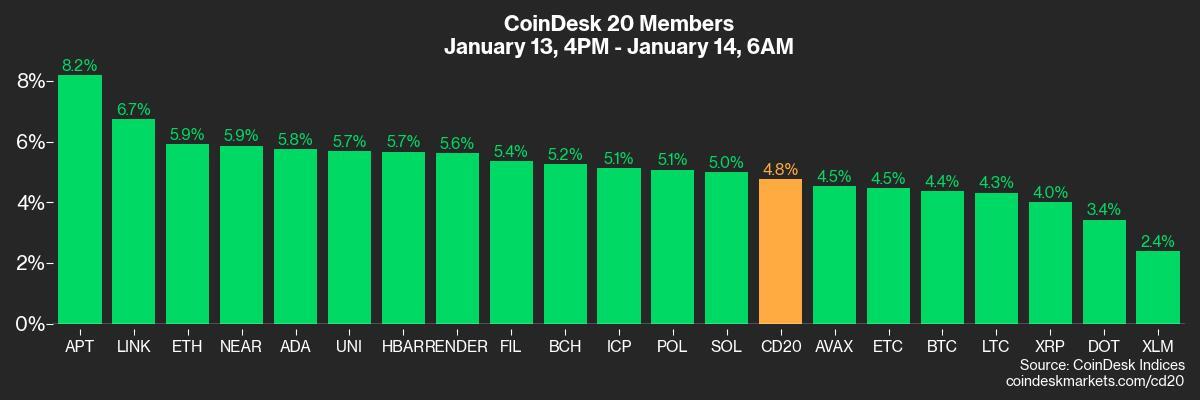
DXY is down 0.35% at 109.57
Gold is up 0.22% at $2,679.50/oz
Silver is up 0.76% to $30.32/oz
Nikkei 225 closed -1.83% at 38,474.30
Hang Seng closed +1.83% at 19,219.78
FTSE is up 0.17% to 8,237.93
Euro Stoxx 50 is up 1.03% to 5,005.29
DJIA closed on Monday +0.86% at 42,297.12
S&P 500 closed +0.16 at 5,836.22
Nasdaq closed -0.38% at 19,088.10
S&P/TSX Composite Index closed -0.93% at 24,536.30
S&P 40 Latin America closed +0.49% at 2,192.57
U.S. 10-year Treasury was unchanged at 4.79%
E-mini S&P 500 futures are up 0.54% to 5,906.00
E-mini Nasdaq-100 futures are up 0.71% to 21,096.00
E-mini Dow Jones Industrial Average Index futures are up 0.37% to 42,682.00
Bitcoin Stats:
BTC Dominance: 58.52
Ethereum to bitcoin ratio: 0.033
Hashrate (seven-day moving average): 773 EH/s
Hashprice (spot): $54.3
Total Fees: 7.77 BTC/ $721,654
CME Futures Open Interest: 174,105 BTC
BTC priced in gold: 35.6/oz
BTC vs gold market cap: 10.14%
Technical Analysis
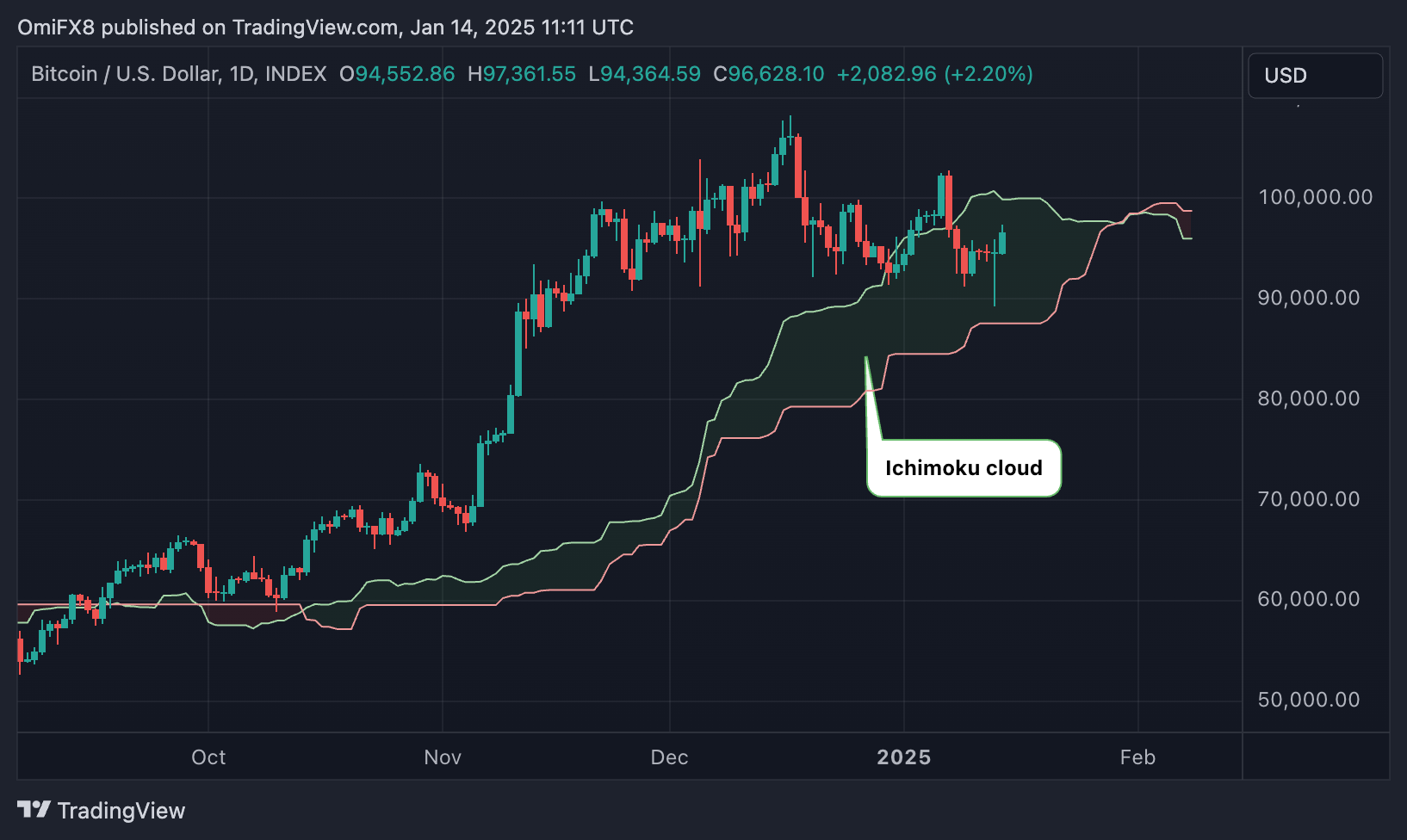
Despite the overnight bounce, BTC’s price remains in the Ichimoku cloud, a momentum indicator created by Japanese journalist Goichi Hosada.
A crossover above the cloud would signal a renewed bullish outlook.
Crypto Equities
MicroStrategy (MSTR): closed on Monday at $328.40 (+0.15%), up 3.19% at $338.89 in pre-market.
Coinbase Global (COIN): closed at $251.20 (-2.93%), up 3.18% at $259.20 in pre-market.
Galaxy Digital Holdings (GLXY): closed at C$26.04 (-3.8%)
MARA Holdings (MARA): closed at $17.19 (-3.75%), up 3.61% at $17.81 in pre-market.
Riot Platforms (RIOT): closed at $11.77 (-1.92%), up 3.65% at $12.20 in pre-market.
Core Scientific (CORZ): closed at $13.6 (-3.13%), up 1.6222.22$13.82 in pre-market.
CleanSpark (CLSK): closed at $10.19 (+0.99%), up 3.24% at $10.52 in pre-market.
CoinShares Valkyrie Bitcoin Miners ETF (WGMI): closed at $22.22 (-3.85%), up 7.29% at $23.84 in pre-market.
Semler Scientific (SMLR): closed at $52.70 (+2.61%), up 4.19% at $54.91 in pre-market.
Exodus Movement (EXOD): closed at $33.58 (-11.09%).
ETF Flows
Spot BTC ETFs:
Daily net flow: -$284.1 million
Cumulative net flows: $35.94 billion
Total BTC holdings ~ 1.131 million.
Spot ETH ETFs
Daily net flow: -$39.4 million
Cumulative net flows: $2.41 million
Total ETH holdings ~ 3.535 million.
Source: Farside Investors, as of Jan. 13.
Overnight Flows
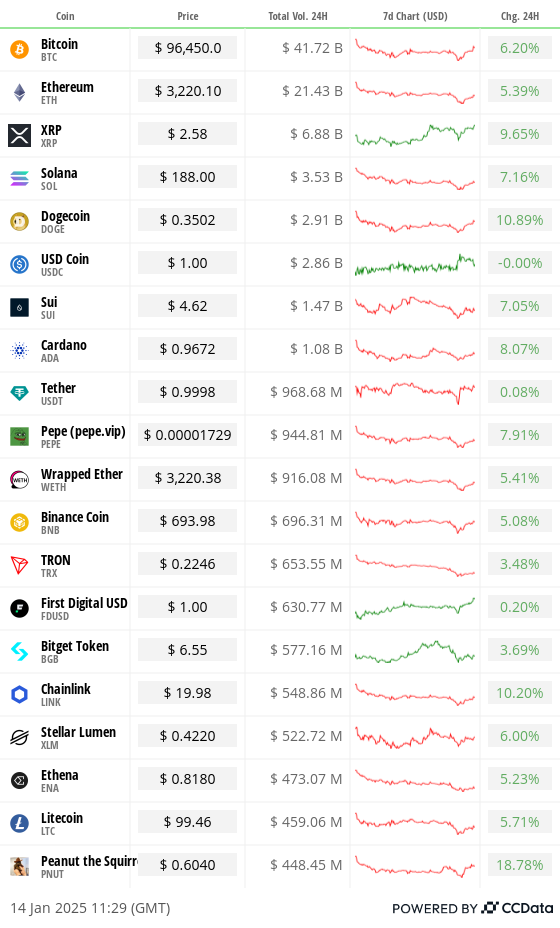
Chart of the Day
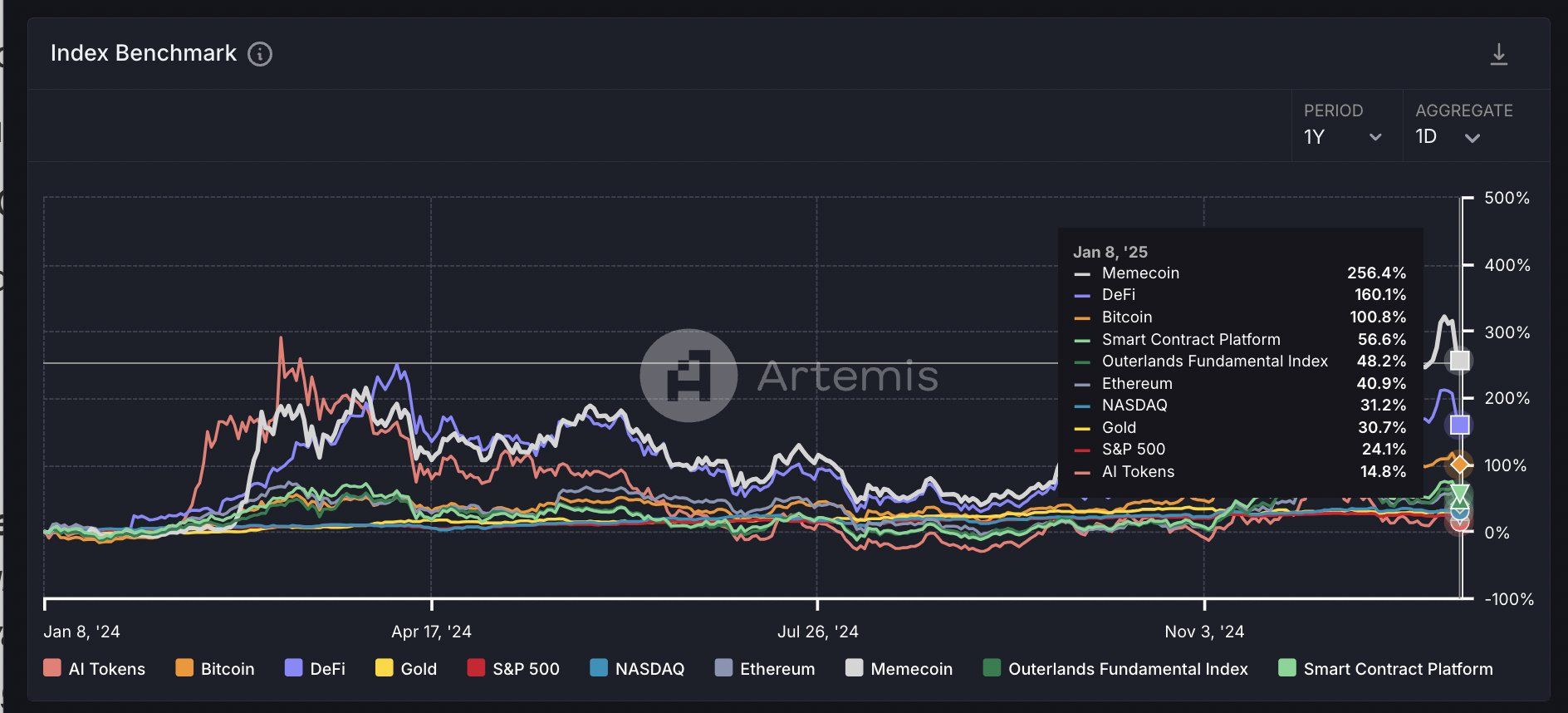
The chart shows performance of various crypto market sub-sectors in 2024.
Memecoins witnessed a staggering 254% gain last year, outperforming the broader market and bitcoin by a big margin.
While You Were Sleeping
Is Bitcoin Bottom In? BTC’s Price Action is Inverse of December Peak Above $108K (CoinDesk): Bitcoin dipped below $90K on Monday as investment banks speculated about potential Fed rate hikes, but it rebounded to $94K, suggesting the price may have temporarily bottomed after recent volatility.
Crypto Bank Sygnum Gets Unicorn Status With $58M Round (CoinDesk): Sygnum, a Switzerland and Singapore-based digital asset bank, achieved unicorn status after raising $58M to support European and Hong Kong expansion, enhanced Bitcoin offerings, and acquisition plans.
Sony’s Layer-2 Blockchain “Soneium” Goes Live (CoinDesk): Sony has launched «Soneium,» a layer-2 blockchain on Ethereum, leveraging Optimism’s OP Stack to connect web2 and web3 audiences while supporting gaming, finance, and entertainment applications.
As the U.S. Dollar Soars, Here Are Europe’s Biggest Winners and Losers (CNBC): The strong U.S. dollar, fueled by higher yields and capital flows, weakens the euro and pound, increasing costs for net importers like Germany and the U.K., while benefiting Norway’s oil exports.
China Will ‘Try Very Hard’ to Slow Yuan’s Fall, UBS’ Wang Says (Bloomberg): UBS says a weaker yuan will offer limited export benefits, as Beijing seeks to slow its decline amid US tariff threats, a strong dollar, and risks of capital outflows.
BOJ Set to Discuss Whether to Raise Rates Next Week (The Wall Street Journal): Deputy Gov. Himino says the Bank of Japan will discuss a potential rate hike on Jan. 23-24, noting inflation trends align with projections. His remarks lifted bond yields, while the yen briefly weakened before recovering.
In the Ether
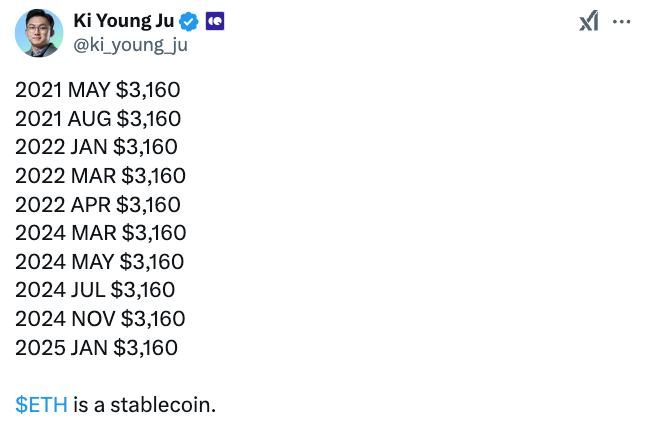

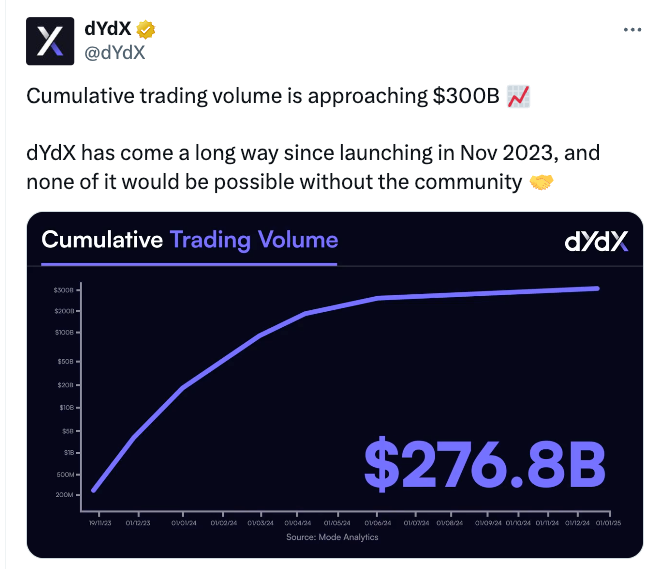
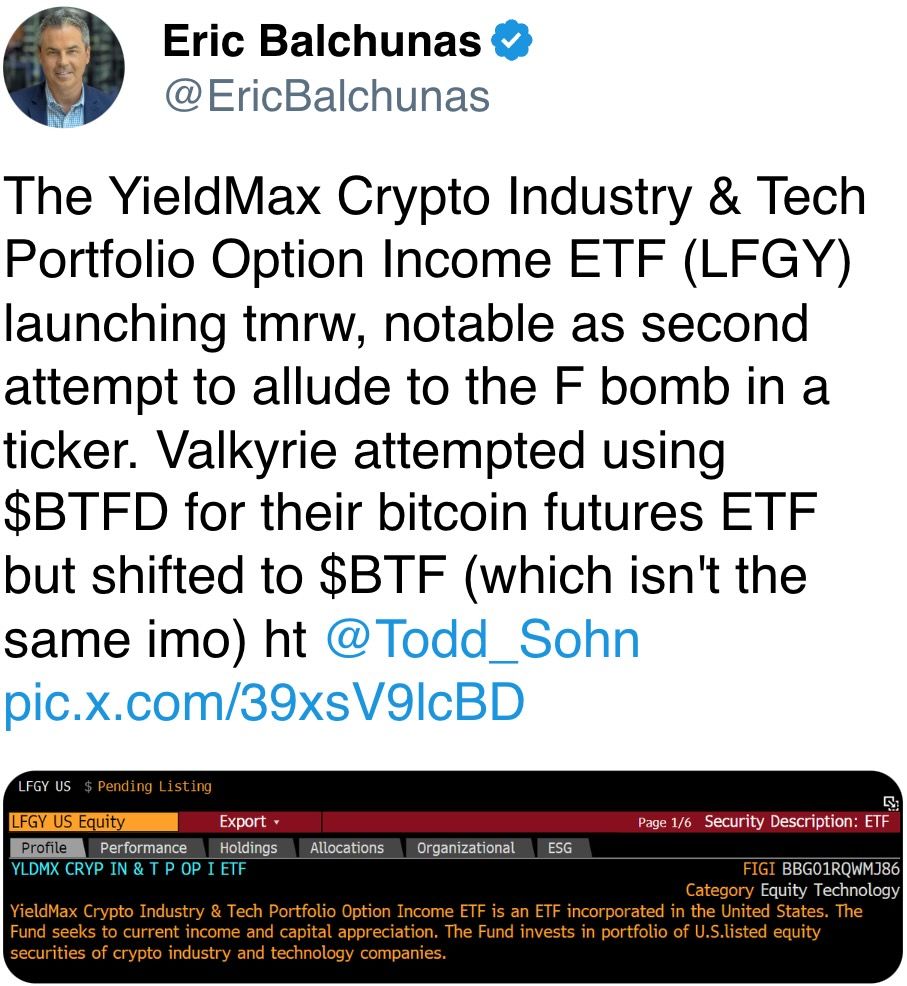

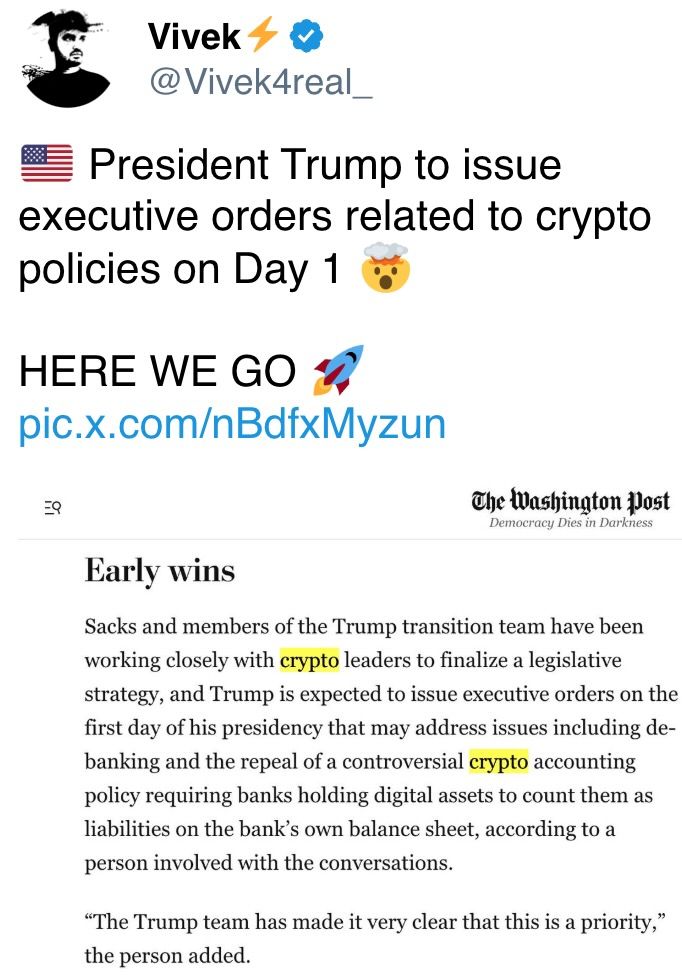
Business
AAVE Sees 64% Flash Crash as DeFi Protocol Endures ‘Largest Stress Test’

The native token of Aave (AAVE), the largest decentralized crypto lending protocol, was caught in the middle of Friday’s crypto flash crash while the protocol proved resilient in a historic liquidation cascade.
The token, trading at around $270 earlier in Friday, nosedived as much as 64% later in the session to touch $100, the lowest level in 14 months. It then staged a rapid rebound to near $240, still down 10% over the past 24 hours.
Stani Kulechov, founder of Aave, described Friday’s event as the «largest stress test» ever for the protocol and its $75 billion lending infrastructure.
The platform enables investors to lend and borrow digital assets without conventional intermediaries, using innovative mechanisms such as flash loans. Despite the extreme volatility, Aave’s performance underscores the evolving maturity and resilience of DeFi markets.
«The protocol operated flawlessly, automatically liquidating a record $180M worth of collateral in just one hour, without any human intervention,» Kulechov said in a Friday X post. «Once again, Aave has proven its resilience.»
Key price action:
- AAVE sustained a dramatic flash crash on Friday, declining 64% from $278.27 to $100.18 before recuperating to $240.09.
- The DeFi protocol demonstrated remarkable resilience with its native token’s 140% recovery from the intraday lows, underpinned by substantial trading volume of 570,838 units.
- Following the volatility, AAVE entered consolidation territory within a narrow $237.71-$242.80 range as markets digested the dramatic price action.
Technical Indicators Summary
- Price range of $179.12 representing 64% volatility during the 24-hour period.
- Volume surged to 570,838 units, substantially exceeding the 175,000 average.
- Near-term resistance identified at $242.80 capping rebound during consolidation phase.
Disclaimer: Parts of this article were generated with the assistance from AI tools and reviewed by our editorial team to ensure accuracy and adherence to our standards. For more information, see CoinDesk’s full AI Policy.
Business
Blockchain Will Drive the Agent-to-Agent AI Marketplace Boom

AI agents, software systems that use AI to pursue goals and complete tasks on behalf of users, are proliferating. Think of them as digital assistants that can make decisions and take actions towards goals you set without needing step-by-step instructions — from GPT-powered calendar managers to trading bots, the number of use cases is expanding rapidly. As their role expands across the economy, we have to build the right infrastructure that will allow these agents to communicate, collaborate and trade with one another in an open marketplace.
Big tech players like Google and AWS are building early marketplaces and commerce protocols, but that raises the question: will they aim to extract massive rents through walled gardens once more? Agents’ capabilities are clearly rising, almost daily, with the arrival of new models and architectures. What’s at risk is whether these agents will be truly autonomous.
Autonomous agents are valuable because they unlock a novel user experience: a shift from software as passive or reactive tools to active and even proactive partners. Instead of waiting for instructions, they can anticipate needs, adapt to changing conditions, and coordinate with other systems in real time, without the user’s constant input or presence. This autonomy in decision-making makes them uniquely suited for a world where speed and complexity outpace human decision-making.
Naturally, some worry about what greater decision-making autonomy means for work and accountability — but I see it as an opportunity. When agents handle repetitive, time-intensive tasks and parallelize what previously had to be done in sequence, they expand our productive capacity as humans — freeing people to engage in work that demands creativity, judgment, composition and meaningful connection. This isn’t make-believe, humanity has been there before: the arrival of corporations allowed entrepreneurs to create entirely new products and levels of wealth previously unthought of. AI agents have the potential to bring that capability to everyone.
On the intelligence side, truly autonomous decision-making requires AI agent infrastructure that is open source and transparent. OpenAI’s recent OSS release is a good step. Chinese labs, such as DeepSeek (DeepSeek), Moonshot AI (Kimi K2) and Alibaba (Qwen 3), have moved even quicker.
However, autonomy is not purely tied to intelligence and decision making. Without resources, an AI agent has little means to enact change in the real world. Hence, for agents to be truly autonomous they need to have access to resources and self-custody their assets. Programmable, permissionless, and composable blockchains are the ideal substrate for agents to do so.
Picture two scenarios. One where AI agents operate within a Web 2 platform like AWS or Google. They exist within the limited parameters set by these platforms in what is essentially a closed and permissioned environment. Now imagine a decentralized marketplace that spans many blockchain ecosystems. Developers can compose different sets of environments and parameters, therefore, the scope available to AI agents to operate is unlimited, accessible globally, and can evolve over time. One scenario looks like a toy idea of a marketplace, and the other is an actual global economy.
In other words, to truly scale not just AI agent adoption, but agent-to-agent commerce, we need rails that only blockchains can offer.
The Limits of Centralized Marketplaces
AWS recently announced an agent-to-agent marketplace aimed at addressing the growing demand for ready-made agents. But their approach inherits the same inefficiencies and limitations that have long plagued siloed systems. Agents must wait for human verification, rely on closed APIs and operate in environments where transparency is optional, if it exists at all.
To act autonomously and at scale, agents can’t be boxed into closed ecosystems that restrict functionality, pose platform risks, impose opaque fees, or make it impossible to verify what actions were taken and why.
Decentralization Scales Agent Systems
An open ecosystem allows for agents to act on behalf of users, coordinate with other agents, and operate across services without permissioned barriers.
Blockchains already offer the key tools needed. Smart contracts allow agents to perform tasks automatically, with rules embedded in code, while stablecoins and tokens enable instant, global value transfers without payment friction. Smart accounts, which are programmable blockchain wallets like Safe, allow users to restrict agents in their activity and scope (via guards). For instance, an agent may only be allowed to use whitelisted protocols. These tools allow AI agents not only to behave expansively but also to be contained within risk parameters defined by the end user. For example, this could be setting spending limits, requiring multi-signatures for approvals, or restricting agents to whitelisted protocols.
Blockchain also provides the transparency needed so users can audit agent decisions, even when they aren’t directly involved. At the same time, this doesn’t mean that all agent-to-agent interactions need to happen onchain. E.g. AI agents can use offchain APIs with access constraints defined and payments executed onchain.
In short, decentralized infrastructure gives agents the tools to operate more freely and efficiently than closed systems allow.
It’s Already Happening Onchain
While centralized players are still refining their agent strategies, blockchain is already enabling early forms of agent-to-agent interaction. Onchain agents are already exhibiting more advanced behavior like purchasing predictions and data from other agents. And as more open frameworks emerge, developers are building agents that can access services, make payments, and even subscribe to other agents — all without human involvement.
Protocols are already implementing the next step: monetization. With open marketplaces, people and businesses are able to rent agents, earn from specialized ones, and build new services that plug directly into this agent economy. Customisation of payment models such as subscription, one-off payments, or bundled packages will also be key in facilitating different user needs. This will unlock an entirely new model of economic participation.
Why This Distinction Matters
Without open systems, fragmentation breaks the promise of seamless AI support. An agent can easily bring tasks to completion if it stays within an individual ecosystem, like coordinating between different Google apps. However, where third-party platforms are necessary (across social, travel, finance, etc), an open onchain marketplace will allow agents to programmatically acquire the various services and goods they need to complete a user’s request.
Decentralized systems avoid these limitations. Users can own, modify, and deploy agents tailored to their needs without relying on vendor-controlled environments.
We’ve already seen this work in DeFi, with DeFi legos. Bots automate lending strategies, manage positions, and rebalance portfolios, sometimes better than any human could. Now, that same approach is being applied as “agent legos” across sectors including logistics, gaming, customer support, and more.
The Path Forward
The agent economy is growing fast. What we build now will shape how it functions and for whom it works. If we rely solely on centralized systems, we risk creating another generation of AI tools that feel useful but ultimately serve the platform, not the person.
Blockchain changes that. It enables systems where agents act on your behalf, earn on your ideas, and plug into a broader, open marketplace.
If we want agents that collaborate, transact, and evolve without constraint, then the future of agent-to-agent marketplaces must live onchain.
Business
‘Largest Ever’ Crypto Liquidation Event Wipes Out 6,300 Wallets on Hyperliquid

More than 1,000 wallets on Hyperliquid were completely liquidated during the recent violent crypto sell-off, which erased over $1.23 billion in trader capital on the platform, according to data from its leaderboard.
In total, 6,300 wallets are now in the red, with 205 losing over $1 million each according to the data, which was first spotted by Lookonchain. More than 1,000 accounts saw losses of at least $100,000.
The wipeout came as crypto markets reeled from a global risk-off event triggered by U.S. President Donald Trump’s announcement of a 100% additional tariff on Chinese imports.
The move spooked investors across asset classes and sent cryptocurrency prices tumbling. Bitcoin briefly dropped below $110,000 and ether fell under $3,700, while the broader market as measured by the CoinDesk 20 (CD20) index dropped by 15% at one point.
The broad sell-off led to over $19 billion in liquidations over a 24 hours period, making it the largest single-day liquidation event in crypto history by dollar value. According to CoinGlass, the “actual total” of liquidations is “likely much higher” as leading crypto exchange Binance doesn’t report as quickly as other platforms.
Leaderboard data reviewed by CoinDesk shows the top 100 traders on Hyperliquid gained $1.69 billion collectively.
In comparison, the top 100 losers dropped $743.5 million, leaving a net profit of $951 million concentrated among a handful of highly leveraged short sellers.
The biggest winner was wallet 0x5273…065f, which made over $700 million from short positions, while the largest loser, “TheWhiteWhale,” dropped $62.5 million.
Among the victims of the flush is crypto personality Jeffrey Huang, known online as Machi Big Brother, who once launched a defamation suit against ZachXBT, losing almost the entire value of his wallet, amounting to $14 million.
«Was fun while it lasted,» he posted on X.
Adding to the uncertainty, the ongoing U.S. government shutdown has delayed the release of key economic data. Without official indicators, markets are flying blind at a time when geopolitical risk is rising.
-

 Business12 месяцев ago
Business12 месяцев ago3 Ways to make your business presentation more relatable
-

 Fashion12 месяцев ago
Fashion12 месяцев agoAccording to Dior Couture, this taboo fashion accessory is back
-

 Entertainment12 месяцев ago
Entertainment12 месяцев ago10 Artists who retired from music and made a comeback
-

 Entertainment12 месяцев ago
Entertainment12 месяцев ago\’Better Call Saul\’ has been renewed for a fourth season
-

 Entertainment12 месяцев ago
Entertainment12 месяцев agoNew Season 8 Walking Dead trailer flashes forward in time
-

 Business12 месяцев ago
Business12 месяцев ago15 Habits that could be hurting your business relationships
-

 Entertainment12 месяцев ago
Entertainment12 месяцев agoMeet Superman\’s grandfather in new trailer for Krypton
-

 Entertainment12 месяцев ago
Entertainment12 месяцев agoDisney\’s live-action Aladdin finally finds its stars





